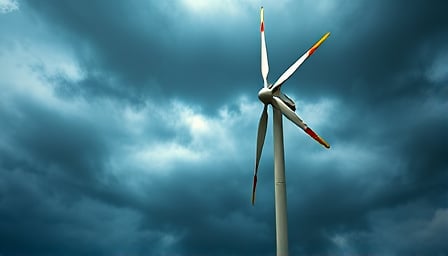Orsted AS: A Financial Storm Brewing Amidst Wind Power Ambitions
In a dramatic turn of events, Orsted AS, the Danish titan in renewable energy, finds itself in the eye of a financial storm. The company, renowned for its pioneering work in offshore wind farms, bioenergy, and waste-to-energy solutions, is grappling with a series of downgrades and a significant plunge in its share price. This tumultuous period raises critical questions about the sustainability of its ambitious projects and the strategic decisions that have led to this precarious situation.
A Cascade of Downgrades
The financial community has sounded alarms over Orsted’s future, with several major banks revising their outlooks on the company. Danske Bank has lowered its target price to 320 DKK from 350 DKK, maintaining a buy recommendation. Fearnley has adjusted its target to 237 DKK from 300 DKK, sticking with a hold stance. Oddo has revised its target to 260 DKK from 310 DKK, reiterating a neutral position. SEB has made a more drastic cut, setting its target at 225 DKK from 300 DKK, yet still advising to hold. Citigroup has taken a bearish stance, reducing its target to 190 DKK from 211 DKK, and advising to sell. Goldman Sachs has also lowered its target to 235 DKK from 300 DKK, maintaining a neutral view. Arctic has gone as far as to downgrade Orsted to a sell from hold, with a target of 180 DKK.
These downgrades reflect a growing skepticism about Orsted’s financial health and its ability to navigate the challenges ahead. The consensus among analysts suggests a company at a crossroads, with its ambitious expansion plans in the U.S. wind power sector casting a long shadow over its prospects.
The $9.4 Billion Gamble
At the heart of Orsted’s current predicament is its decision to seek a staggering $9.4 billion through a share offering. This move, aimed at funding its U.S. wind power projects, has sent shockwaves through the market. The announcement led to a significant drop in Orsted’s share price, with the company’s stock tumbling by 30% in a single day. This drastic measure underscores the financial strain Orsted faces, particularly with its U.S. projects encountering setbacks.
The decision to issue more stock rather than divesting a stake in a wind farm off the U.S. coast has been met with criticism. It signals a desperate bid to shore up finances but at the cost of diluting shareholder value. This strategy raises questions about the company’s long-term viability and its ability to deliver on its ambitious renewable energy goals.
A Global Leader in Turmoil
Orsted’s challenges are not confined to the financial markets. The company’s global leadership in wind power is under threat as it navigates regulatory hurdles and market dynamics, particularly in the U.S. The Trump administration’s curbs on wind farms have added another layer of complexity, forcing Orsted to rethink its strategy and seek alternative funding sources.
Despite these challenges, Orsted remains a key player in the transition to renewable energy. Its commitment to developing offshore wind farms, bioenergy plants, and waste-to-energy solutions is more critical than ever in the fight against climate change. However, the company’s current financial turmoil serves as a stark reminder of the risks and uncertainties inherent in the renewable energy sector.
Looking Ahead
As Orsted seeks to weather this financial storm, the coming months will be crucial. The company’s ability to execute its ambitious projects, particularly in the U.S., will be a litmus test for its resilience and strategic acumen. Stakeholders will be watching closely, hoping that Orsted can navigate these turbulent waters and emerge stronger on the other side.
In the meantime, the financial community remains divided on Orsted’s prospects. While some see the current challenges as temporary setbacks, others view them as indicative of deeper structural issues. What is clear, however, is that Orsted’s journey ahead will be fraught with challenges, requiring bold decisions and strategic foresight to secure its place as a leader in the renewable energy revolution.
